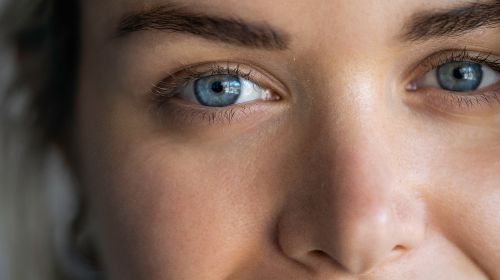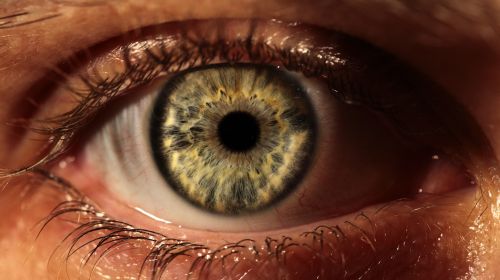Strabismus is a misalignment of the eyes: one eye fixates on the object being seen, the other eye looks in a different direction. In children, untreated squint can lead to permanent vision impairment. How does the eye misalignment occur and what can you do about squinting?
- © Lena May – stock.adobe.com
Quick overview: Frequently asked questions and answers
Why does squinting occur? In most cases, untreated ametropia is the cause. Sometimes there is an injury or inflammation behind the squint or no cause can be found.
What are the consequences of squinting? The two eyes look in different directions. This often causes double vision, poor eyesight, headaches or dizziness.
What helps with strabismus? If there is ametropia, glasses are prescribed. In children, the healthy eye is sometimes taped to strengthen the squinting eye. If that doesn’t help, the misalignment is corrected in an operation.
Article contents at a glance:
What is strabismus?
Normally, both eyes of a person look in the same direction. The two slightly different images are put together in the brain to form a single image – this is the prerequisite for spatial vision and normal visual development.
When you squint (strabismus), your eyes look in different directions and your brain can no longer put the images together correctly. In adults, this often leads to disturbing double vision; in children, squinting can lead to permanent visual impairment.
Experts distinguish between manifest and latent strabismus:
Manifest squint (heterotropy): The misalignment of the eyes is permanent. It occurs in around four percent of people and is therefore a common visual defect. This type is usually congenital and manifests itself in the first years of life.
Latent squint (heterophobia): It only occurs in certain situations, such as when you are tired, stressed or covering an eye. It affects 70 to 80 percent of people; in most cases, latent squint does not cause any symptoms.
Forms of strabismus
Depending on the direction of squinting, the following forms of squinting are also distinguished:
Inward squinting (strabismus convergens, esotropia)
Outward squinting (strabismus divergens, exotropia)
Vertical squint (vertical strabismus) upwards or downwards
Rolling squint (cyclotropia): The visual axis of one eye is twisted.
The cause of squinting is also used to distinguish between different types:
Concomitant strabismus (strabismus concomitans). Squinting is associated with another eye defect (e.g. severe farsightedness). The squint angle is the same in all viewing directions.
Paralytic squint (strabismus paralyticus): At least one of the external eye muscles is responsible for the paralysis. The squint angle differs depending on the direction in which you are looking.
A special form of squint is the so-called microstrabism. The eye misalignment is so minimal that it is often not noticed at all or only noticed very late and is therefore inadequately treated.
Strabismus: causes and risk factors
In many cases, the cause of the squint cannot be determined with certainty. In most cases, however, there is an uncorrected visual defect behind the squint: In this so-called accompanying squint, the more visually impaired eye tries to compensate for the visual impairment by focusing more closely on the near or far distance. This causes the outer eye muscles to become unbalanced. There appears to be a genetic component to this form of squint: if a parent has squint, the risk of squint in the child is significantly increased.
A disease or injury to the eye muscles or nerves is responsible for the so-called paralytic squint. It often occurs very suddenly; possible reasons include inflammation, tumors or circulatory disorders.
Babies born prematurely suffer from strabismus at an above-average rate.
Symptoms: This is how squinting manifests itself
The squint itself is a symptom. It is characterized by the fact that a person’s two eyes do not look in the same direction. The deviation is often hardly noticeable for laypeople, but even small eye misalignments still need to be corrected.
Those affected may notice strabismus due to the following signs:
- Seeing double vision
- blurred vision
- Burning eyes
- Eye tremors (nystagmus)
- Tilting the head
- Squeezing your eyes shut
- clumsy movements
- dizziness
- Headache
- Sensitivity to light
Good to know:
Many babies experience a type of pseudo-squint in the first few months of life because they are just learning to fixate on things with their eyes. However, if the child still has frequent squints after the age of 4 months, parents should have this checked by a doctor.
Diagnosis: This is how strabismus is diagnosed
The diagnosis of strabismus begins with a detailed conversation in the ophthalmologist’s office (anamnesis), during which they also ask about strabismus in the family. An examination is then carried out
- the eye position,
- the mobility of the eyes and
- eyesight can be checked.
Using an uncovering and covering test, the doctor or orthoptist examines how the eyes behave when one of them is covered – this is how latent strabismus can be discovered.
In the so-called Hirschberg test, a light is shined between the affected person’s eyes at the bridge of the nose. If the light reflections on the cornea are not in the same place in both eyes, this is a squint.
Therapy How is strabismus treated?
If squinting is the result of ametropia, this is corrected with glasses. If the squinting eye is already too weak, a so-called occlusion treatment is an option – especially in children. The non-squinting eye is covered with a plaster or an eye patch for hours or days to train the other eye.
If this treatment is not successful, the misalignment of the outer eye muscles can be corrected through surgery. During squint surgery, the squint angle of the affected eye is corrected so that the axis of the eye is parallel to the healthy eye.
Latent squint in adults is sometimes treated with special exercises designed to train the muscles of the weak eye.
If paralysis squint is present, the cause of the muscle paralysis must first be found and then treated accordingly.
Course and prognosis of squinting
The earlier strabismus is treated, the better the chances of recovery. If a child’s squint is not treated early, the visual acuity of the squinting eye becomes weaker. In 60 percent of cases, poor vision (amblyopia) occurs in this eye, which can lead to blindness.
Prevention: How can you prevent strabismus?
There is no prophylaxis against strabismus. However, with regular check-ups at a pediatrician or ophthalmologist, strabismus can also be detected and treated in babies and small children.


